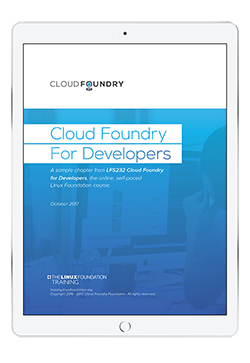We’ve been talking a lot about the cloud on Linux.com lately, with a look at the recent KubeCon + CloudNativeCon Europe in Copenhagen and new Linux and cloud training options, including a new Certified Kubernetes Application Developer (CKAD) Exam and corresponding Kubernetes for Developers course through the Cloud Native Computing Foundation.
We also just wrapped up a tutorial series previewing the Cloud Foundry for Developers training course. In these articles, we provided an overview of Cloud Foundry and how to get started using it to develop applications. The first three articles covered basic concepts, terminology, and architecture. Then, in the last two articles, we showed how to write and push an app to a Cloud Foundry instance. You can catch up on the entire series here:

And download the sample chapter for more information.
The Cloud Foundry for Developers training course teaches you how to use Cloud Foundry to build, deploy and manage a cloud-native microservices solution. Topics include:
-
Cloud Foundry Motivators: Industry changes which have led to the cloud-native movement and the role of Cloud Foundry in the enterprise.
-
Basic Definitions & Core Themes: Established a basic lexicon around simple Cloud Foundry concepts like targets, orgs, spaces, users, and roles.
-
Technical Overview: The main technical components/areas of Cloud Foundry, from the perspective of a developer interacting with the platform.
-
Best Practices: Best practices for designing, deploying, and managing applications.
-
Security: Using Cloud Foundry to secure applications and endpoints.
-
CI/CD & Automation: Best practices in automating the lifecycle of applications.
The information in this article series is based on the Cloud Foundry for Developers (LFD232) training course from Cloud Foundry and The Linux Foundation. You can download a sample chapter here.


